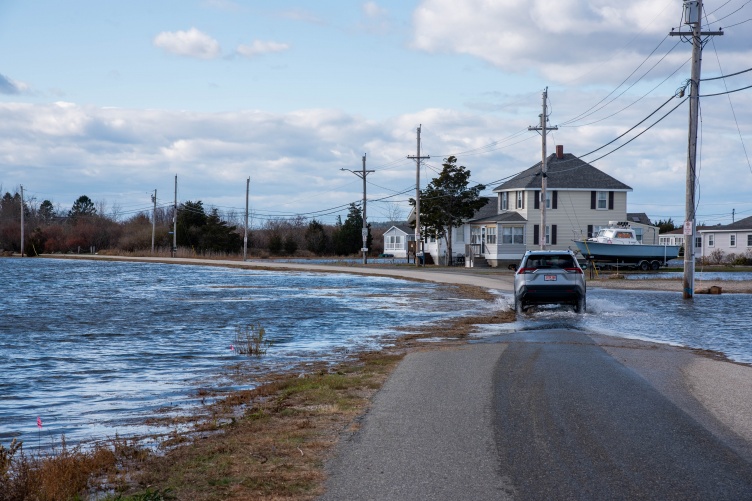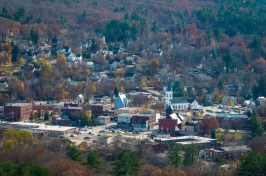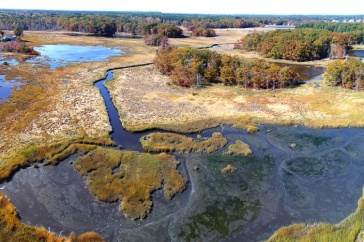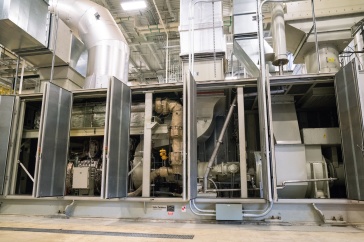
Without a reduction in greenhouse gas emissions, New Hampshire will see increased flooding that threatens infrastructure.
UNH climate scientists have released a new report cautioning that the Granite State has become increasingly warmer and wetter since the 1970s. The state can expect a “new normal” with concerningly high temperatures and more extreme precipitation events if changes are not made to reduce emissions and greenhouse gases and transition to efficient, low-carbon sources of energy.
“Human driven climate change is happening now and we’re at a critical crossroads.”
“This is not something that is just a problem for the future,” says Cameron Wake, research professor in climatology and glaciology and an author of the report. “Human driven climate change is happening now and we’re at a critical crossroads. Those trends could get exponentially worse if we don’t take some action to slow the process and rapidly decrease emissions.”
The 2021 N.H. Climate Assessment Report says that by the year 2100 most of New Hampshire could expect 50 to 60 days a year to be above 90°F unless steps are taken to lower emissions
Key Findings
Since 1901
-
temperatures across New Hampshire increased by an average of 3°F
-
annual precipitation increased 12%
Without reducing emissions, by 2100
- most of New Hampshire could expect 50 to 60 days a year to be above 90°F
- snowfall could decrease by 20 – 50%
- winter temperatures are expected to be 10°F higher
and control the amount of heat-trapping, or greenhouse, gas emitted, in which case the number of days could be cut in half. However, if emissions are not reduced substantially, the demand for energy to cool buildings during hotter summers and longer heat waves could more than double. The report also warns that an increase in summer heat without more rain could lead to drier summer weather and potentially more drought.
Summers are not the only troubling projections in the report. The state’s winters, which attract thousands of recreationists, are warming more rapidly than any other season. Winter temperatures are expected to be an additional 10°F higher by the end of the century and could lead to earlier snowpack melt and an earlier ice-out on the state’s lakes, which is a real concern for the state’s multimillion-dollar winter recreation industry and other weather-dependent industries.
Researchers project the increase could be contained closer to a 6°F temperature rise if emissions were lowered. The study also points to a warmer and longer spring and fall and shows that annual rainfall, which has increased more than eight inches since 1901, is expected to rise another 7-9% by the middle of the century. Most of this uptick is projected to happen because of a growth in heavy precipitation events, significantly increasing the risk of flooding impacting everything from roads to real estate.
“There’s not only a concern about warming temperatures but also more extreme weather events,” says Mary Stampone, associate professor of geography and New Hampshire state climatologist, co-author of the report, along with Wake and research assistant professor Elizabeth Burakowski. “For instance, an increase in the amount of rain could threaten the state’s infrastructure because many of our storm water systems, built decades ago, were not designed for the higher surface runoff we see now, let alone what we expect in the coming decades. We’re already seeing these issues along the Seacoast.”
The report looked at data from 10 communities around New Hampshire, from Colebrook to Keene to the Seacoast, and offers not only the science behind these projections but forecasts what would happen if significant emission reduction were pursued. It highlights how different warming scenarios could tip the delicate balance in ecosystems, noting the potential increase in the number of invasive species and disease-carrying insects which could be an issue for both wildlife and humans.
Research for this report was funded in part by the National Science Foundation’s Established Program to Stimulate Competitive Research (EPSCoR).
-
Written By:
Robbin Ray ’82 | UNH Marketing | robbin.ray@unh.edu | 603-862-4864


















































